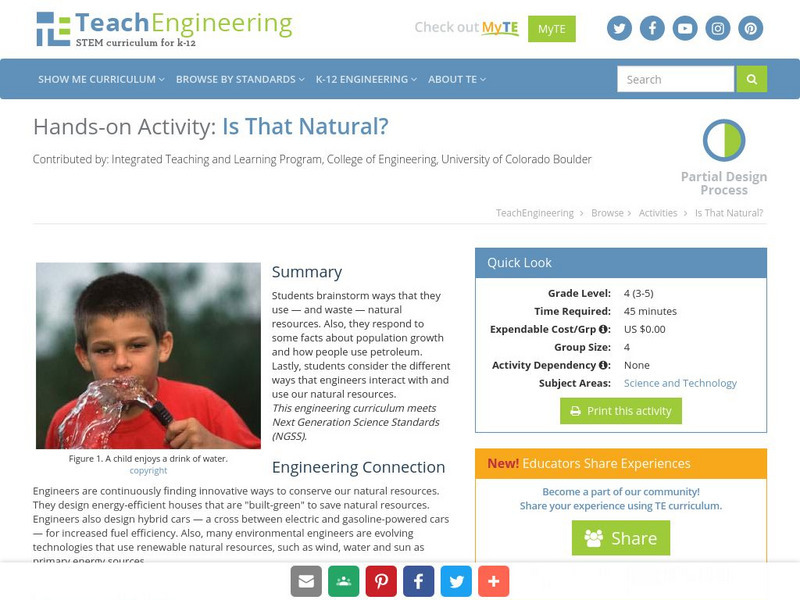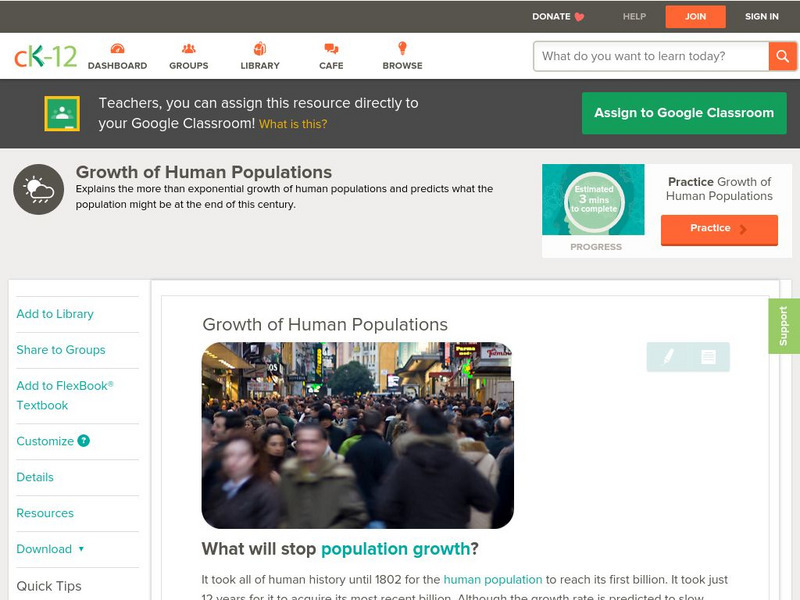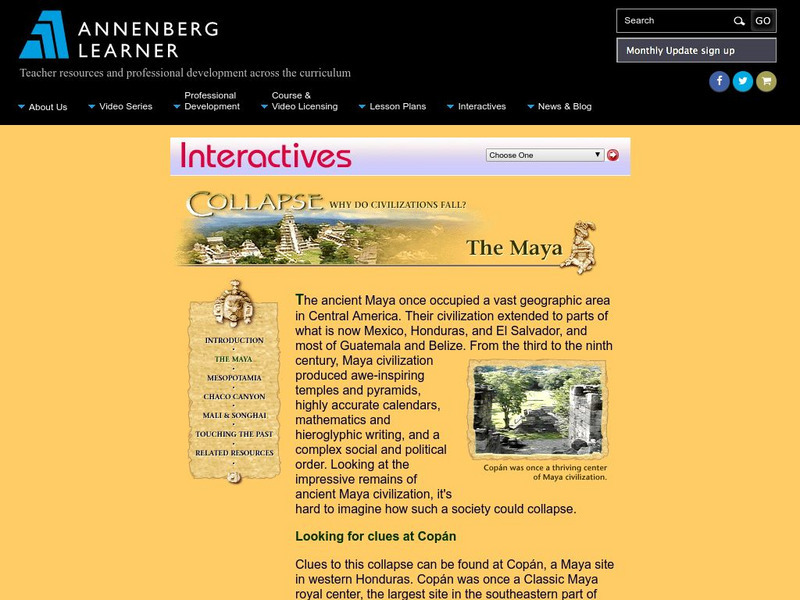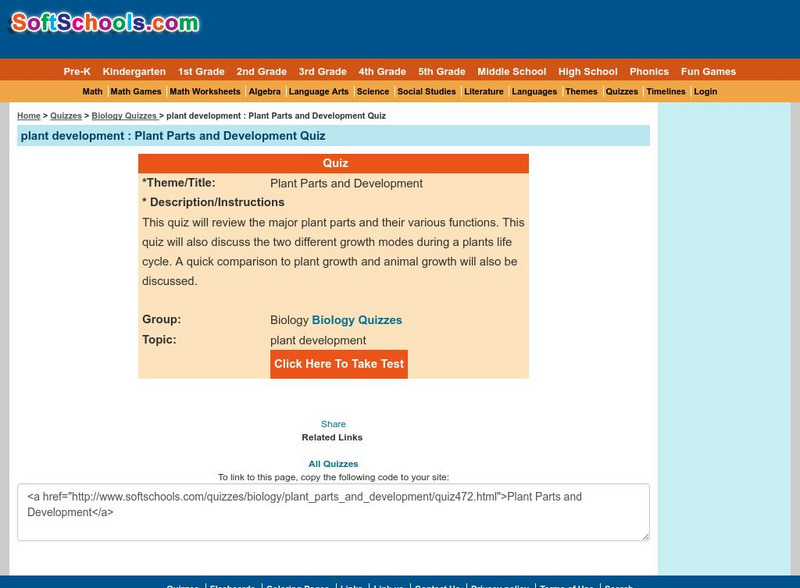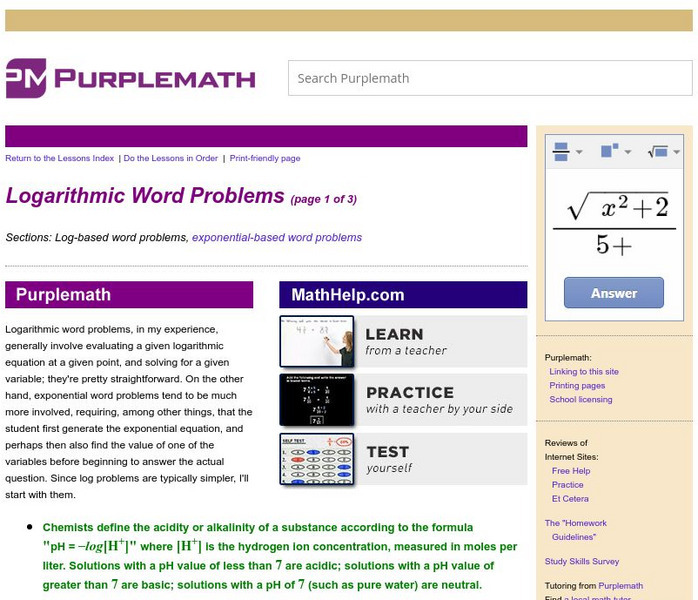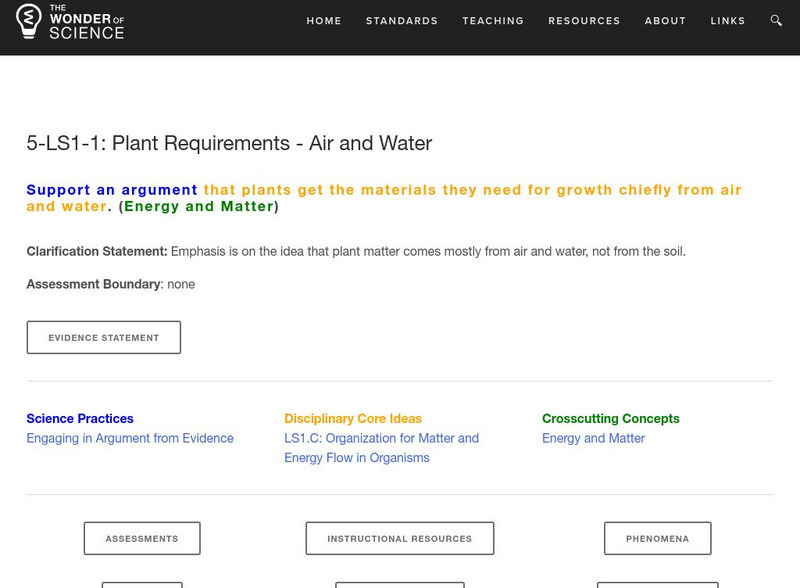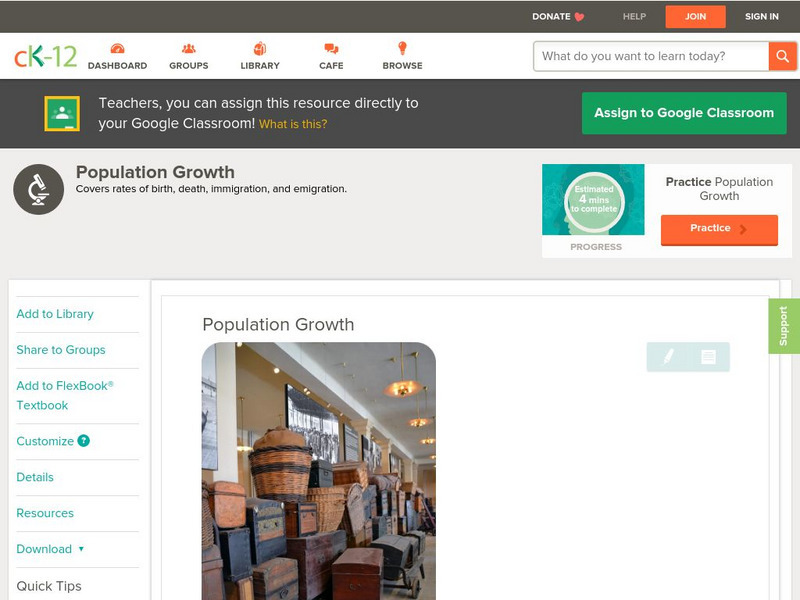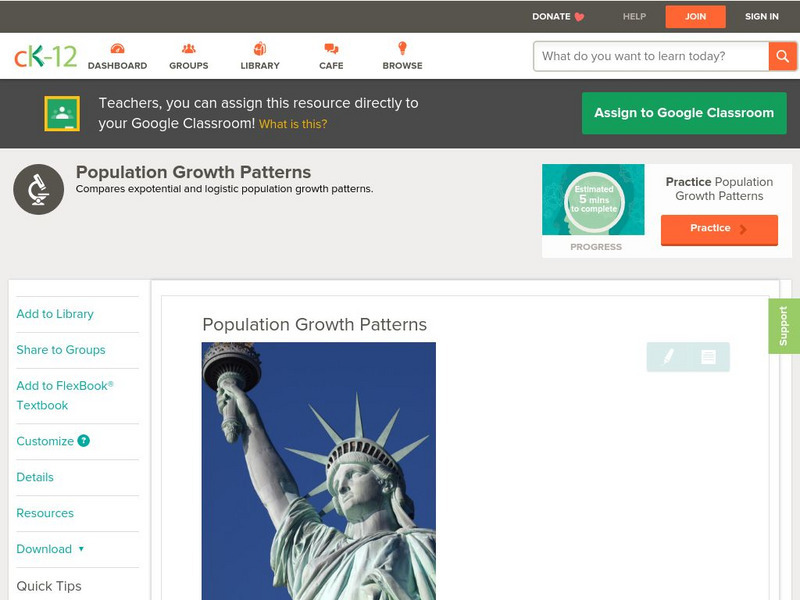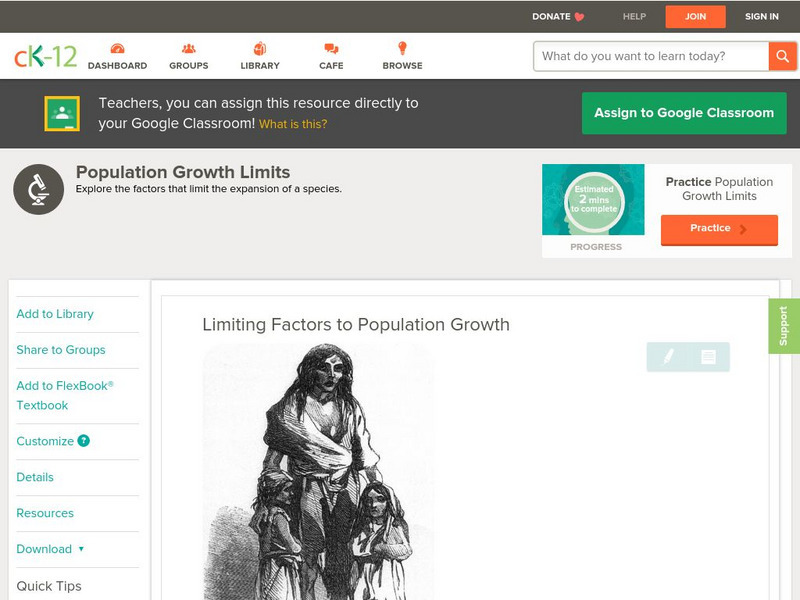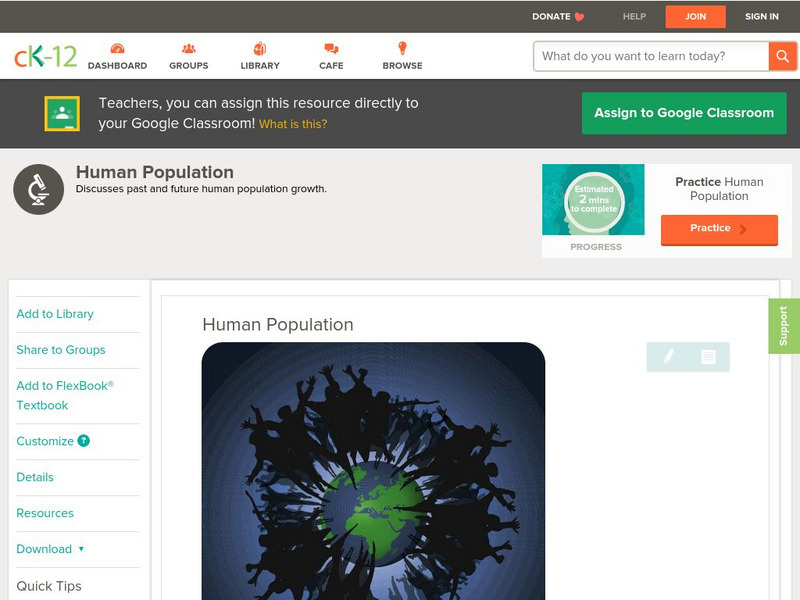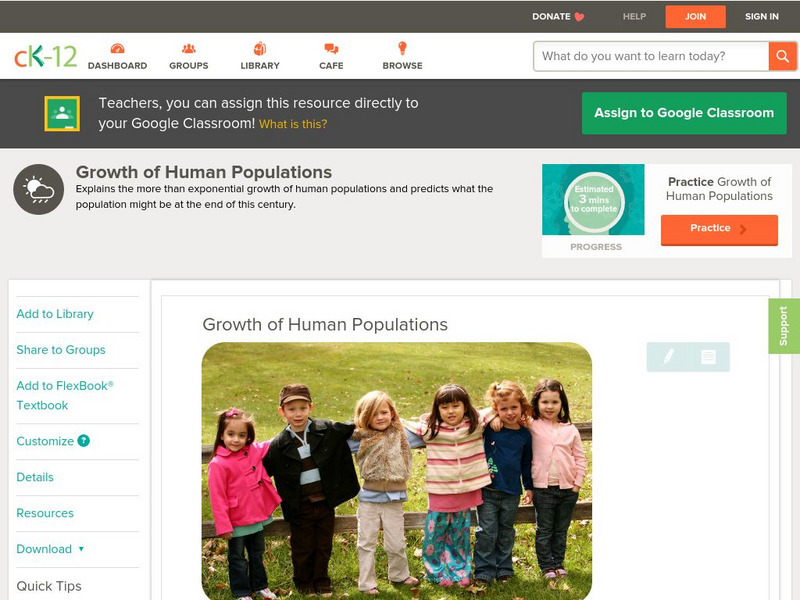TeachEngineering
Teach Engineering: Is That Natural?
Students will brainstorm ways that they use - and waste - natural resources. Also, they will respond to some facts about population growth and how people use petroleum. Lastly, students will consider the different ways that engineers...
TeachEngineering
Teach Engineering: The Great Divide
In this activity, students will use cookies to simulate the distribution of our nonrenewable resources (energy). Then, they will discuss how the world's growing population affects the fairness and effectiveness of this distribution of...
CK-12 Foundation
Ck 12: Biology: Recent and Future Population Growth
[Free Registration/Login may be required to access all resource tools.] Discusses recent human population growth and predictions of future population growth.
CK-12 Foundation
Ck 12: Earth Science: Growth of Human Populations
[Free Registration/Login may be required to access all resource tools.] Describes how the human population is rapidly expanding.
Utah Education Network
Uen: Seed House
Students will communicate in oral, artistic, written and nonverbal form as they study seeds and their growth. Students will plant seeds, make observations about the seeds' growth, and report their observations to peers .
Annenberg Foundation
Annenberg Learner: Collapse: The Maya
Captivating site containing information about the collapse of civilizations. It explores the needs and characteristics of a healthy civilization that must be maintained in order to avoid collapse.
Soft Schools
Soft Schools: Plant Parts and Development Quiz
Take an interactive quiz over plant parts and plant development. After completing the quiz, check your score, and then revisit any incorrect question for further review.
University of Saskatchewan (Canada)
University of Saskatchewan: Modelling Natural Growth
This site shows how to model exponential growth. The site walks the student through an example problem using logarithms to find the exponential growth of the theoretical world population.
Scholastic
Scholastic: Study Jams! Science: Animals: Animal Life Cycles
A slideshow and a short multiple-choice quiz on the topic of animal life cycles.
A-Z Animals
A Z Animals: Reference: Life Cycles
Find out some common characteristics of animal life cycles across different types of species.
Other
Mother Jones: What It Will Take
This blog article discusses population growth in the context of wealth, poverty, women's rights and birth control.
BBC
Bbc: Gcse Bitesize: Cell Structures
Organisms are made of cells. Most organisms are multicellular and have cells that are specialised to do a particular job. Microscopes produce magnified images of cells so we can study them in detail. This lesson focuses on animal cells.
BBC
Bbc: Gcse Bitesize: Cell Division
This lesson focuses on cell division including how chromosomes are formed from DNA, how many chromosomes there are in the human body, and diagrams of cell division. It also provides links to a video and a test.
TED Talks
Ted: Ted Ed: What Is the Tragedy of the Commons?
In 1968, Garrett Hardin sat down to write an essay about overpopulation. Within it, he discovered a pattern of human behavior that explains some of history's biggest problems. Nicholas Amendolare describes the tragedy of the commons.
Purple Math
Purplemath: Logarithmic Word Problems
Logarithmic word problems generally involve evaluating a given logarithmic equation at a given point, and solving for a given variable; they're pretty straightforward. This resource contains worked examples to demonstrate the reasoning...
Better Lesson
Better Lesson: Animal Life Cycles Introduction
Third graders will explain commonalities in animal life cycles as well and to compare life cycles of different animal groups.
American Institute of Biological Sciences
Action Bioscience: Population and the Environment: Global Challenge
Look globally at the rising population and understand the impact on the environment, water supply, forestry, and biodiversity through the article and its supporting resources.
The Wonder of Science
The Wonder of Science: 5 Ls1 1: Plant Requirements: Air and Water
Create lessons to show that plants use air and water primarily to grow with help from the resources on this site. Use the work samples, phenomena, assessment templates, and videos to help students understand the requirements of plants to...
CK-12 Foundation
Ck 12: Biology: Population Growth
[Free Registration/Login may be required to access all resource tools.] Describes how rates of birth, death, immigration, and emigration affect population growth.
CK-12 Foundation
Ck 12: Life Science: Population Growth Patterns
[Free Registration/Login may be required to access all resource tools.] What does population growth mean? You can probably guess that it means the number of individuals in a population is increasing. The population growth rate tells you...
CK-12 Foundation
Ck 12: Life Science: Limiting Factors to Population Growth
[Free Registration/Login may be required to access all resource tools.] For a population to be healthy, factors such as food, nutrients, water and space, must be available. Limiting factors are resources or other factors in the...
CK-12 Foundation
Ck 12: Life Science: Human Population
[Free Registration/Login may be required to access all resource tools.] How quickly is the human population growing? If we look at worldwide human population growth from 10,000 BCE through to today, our growth looks like exponential...
CK-12 Foundation
Ck 12: Earth Science: Overpopulation and Over Consumption
[Free Registration/Login may be required to access all resource tools.] Looks at how the human population has grown. Some consume a tremendous amount of resources and produce a lot of waste.
CK-12 Foundation
Ck 12: Earth Science: Growth of Human Populations
[Free Registration/Login may be required to access all resource tools.] Describes how the human population is rapidly expanding.


